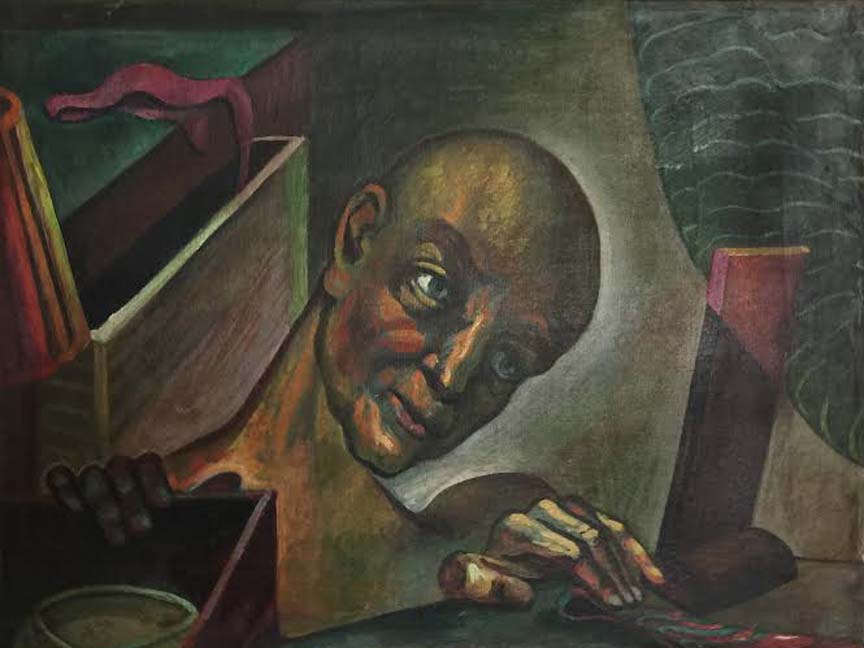

P. R. MACINTOSH
"SURREAL SCENE"
OIL ON CANVAS, SIGNED
AMERICAN, DATED 1945
20 X 26 INCHES
P. R. McIntosh 1897-1985 P. R. McIntosh grew up on a farm in southern Indiana where at the age of twelve he began to draw and sculpt. From around 1910 until his death in 1985, his life revolved aound painting. A retrospective exhibit of his work in 1984 inspired this fitting headline in the local newspaper, "P.R. McIntosh Exhibit Covers 60 Years of Art History." He received his B.S. degree from Bradley University and his B.F.A. and M.F.A. degrees from the Art Institute of Chicago. He studied with Robert Henri. He taught art at Ohio State University (1923-26), was director of the Peoria Art Institute (1926-32), and Director of the Art School at Bradley University (1932-49). He headed the American University of France art faculty in Biarritz, France (1945-46). In 1949 he joined the art faculty at the University of Florida, and he retired in 1968. Although my father's first love always was painting, marriage and a family enticed him to a career in teaching His painting never flagged, but he also developed a prestigious art department at Bradley University and worked to advance art education throughout the midwest. He served as President of the Midwest Art Conference (1940), painted a series of "Four Freedoms" murals to publicize a War Bonds drive (1943); and organized a faculty/student exhibition of paintings at New York's Argent Galleries (1949). At the end of World War II, my father took a year's leave to teach art at the American University at Biarritz, France. The trip home included a stop in Paris and a well-received one-man show at the Galerie Jean Dufresne. When he arrived in the U.S. in 1946 with a trove of vibrant street scenes, portraits, and landscapes, they were a startling contrast to the somber heavily textured studies he had painted during the war years. The glorious opportunities to paint in Biarritz had made his time-consuming administrative work unbearable. In 1949, he joined the art faculty at the University of Florida Department of Art and the family moved to Gainesville. For the next 20 years, my father painted in Mexico, the American West, and old seaport towns in Florida, as well as the large studio in his home on Biven's Arm Lake, a bird sanctuary and a source of ever-changing views of clouds, moss-draped live oaks, water, and wildlife. At age 74, he became intrigued with the island of Dominica in the Lesser Antilles and purchased eight acres of land there. He painted the steep lush mountains, dramatic skies and water, and vivid foliage of every hue. And for the fourth time since 1930, my father built a unique and spacious self-designed and mostly-self-constructed home. My father saw each painting as a means of discovering better ways to communicate the essence of his subject matter. A headline for a 1973 interview put it best: "After 63 Years, He Still Aspires to be a Painter." "You have to seduce the eye before you can appeal to the spectator," he told the reporter. It was this challenging search that kept my father actively painting well into his 80's despite advancing physical disabilities. Always he considered his most recent work came closest to his ultimate goal. Acrylic allowed for new effects, he said, and his "foam rollers on sticks" technique (to counter Parkinson's tremors) was uniquely satisfying. In 1984, a year before Dad's death, colleague Roy Craven told a reporter: "He has a sensual and poetic use of vibrant colors. In some of his recent works where he has simplified the shapes and forms, the color seems more impressive, more powerful and distinctively his." P.R. McIntosh's personal files contain several hundred items including exhibit listings, newspaper clippings, and reviews. The frequent references to his distinctive use of color suggest this to be the most arresting feature of his work. Biography written by the daughter of the artist.
|